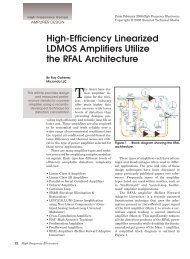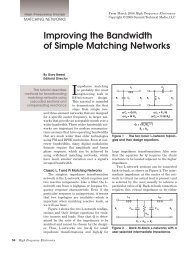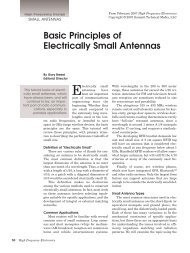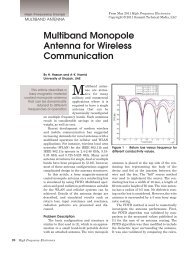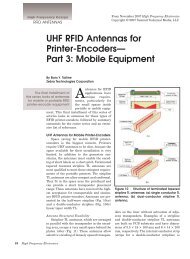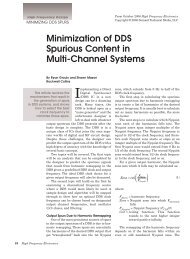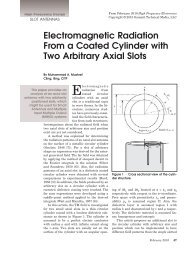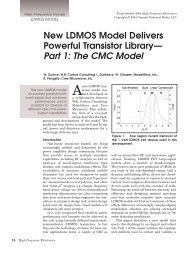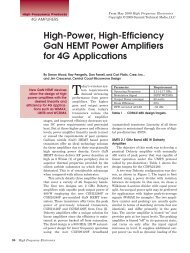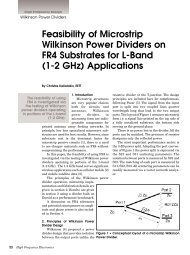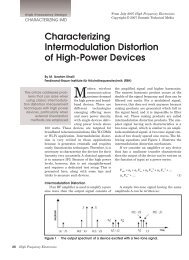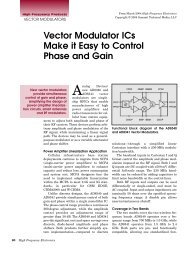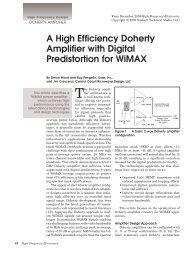A High-Efficiency Transmission-Line GaN HEMT Class E Power ...
A High-Efficiency Transmission-Line GaN HEMT Class E Power ...
A High-Efficiency Transmission-Line GaN HEMT Class E Power ...
Create successful ePaper yourself
Turn your PDF publications into a flip-book with our unique Google optimized e-Paper software.
<strong>High</strong> Frequency Design<br />
CLASS E AMPLIFIER<br />
Figure 2 · Modified transmission-line <strong>Class</strong> E power<br />
amplifier.<br />
the second and third harmonics by using a 30-degree<br />
open-circuited stub and a short-circuited quarter wave<br />
transmission line is shown in Figure 1(b) [11].<br />
In the latter case intended for a conventional <strong>Class</strong>-E<br />
mode, the following harmonic conditions seen by the<br />
device output at the fundamental-frequency, second and<br />
third harmonic components must be satisfied:<br />
ImZ<br />
where<br />
net<br />
V<br />
R = 0.<br />
5768<br />
P<br />
( 2ω<br />
)= ImZ<br />
( 3ω<br />
)=∞<br />
0 net 0<br />
2<br />
dd<br />
is the nominal <strong>Class</strong> E load-network resistance, V dd<br />
is the<br />
supply voltage, and P out<br />
is the fundamental-frequency<br />
output power delivered to the load [12]. The device output<br />
capacitance C out<br />
should be equal to the nominal <strong>Class</strong> E<br />
shunt capacitance C defined by<br />
C = 0 . 1836<br />
ω R<br />
<br />
( )<br />
Znet ( ω 0 )= R 1 + jtan 49.<br />
054<br />
0<br />
out<br />
(1)<br />
(2)<br />
(3)<br />
(4)<br />
Figure 3 · Load networks seen by the device output at<br />
harmonic frequencies.<br />
and the transformation to the standard load resistance<br />
R L<br />
= 50 ohms is provided by the proper choice of the loadnetwork<br />
transmission-line characteristic impedances [5,<br />
6]. It should be noted that Eqs. (3) and (4) were obtained<br />
for the idealized optimum (or nominal) zero voltage and<br />
zero voltage-derivative <strong>Class</strong> E conditions when device is<br />
operated as a lossless switch and a series fundamentallytuned<br />
resonant circuit provides an infinite impedance for<br />
the second and higher order harmonics. However, for<br />
example, for the practical transmission-line <strong>Class</strong>-E load<br />
networks shown in Figure 1(a), high impedance can be<br />
provided at the second harmonic only. In this case, the<br />
maximum efficiency can be achieved with nonzero voltage<br />
and voltage-derivative conditions, thus providing a second-harmonic<br />
<strong>Class</strong> E approximation when Eqs. (3) and<br />
(4) can be considered as an initial guess, with the optimum<br />
parameters optimized around these values [4].<br />
Modified Approach: Analysis and Design<br />
The <strong>Class</strong>-E load network shown in Figure 1(b) can be<br />
modified in order to obtain simple analytical equations to<br />
explicitly define the transmission line parameters. Such a<br />
modified transmission-line <strong>Class</strong> E load network is shown<br />
in Figure 2, where the combined series quarterwave<br />
transmission line provides an impedance transformation<br />
at the fundamental frequency, and the open-circuited<br />
stubs with electrical lengths of 90° and 30° create the<br />
18 <strong>High</strong> Frequency Electronics



